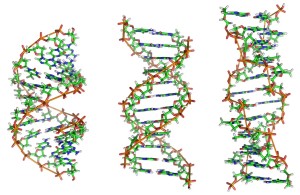 When did human ethnic groups originate? And can the biblical young earth viewpoint explain differences between races today? One research biologist says the biblical model, not evolution, accurately accounts for human DNA diversity today.
When did human ethnic groups originate? And can the biblical young earth viewpoint explain differences between races today? One research biologist says the biblical model, not evolution, accurately accounts for human DNA diversity today.
Dr. Nathaniel Jeanson is a PhD biologist with Answers in Genesis who studied Cell and Developmental Biology at Harvard University. In his latest article, published last week in Answers Research Journal, he considers “why African people groups tends to harbor more mitochaondrial DNA differences than non-African groups.”
According to the young earth creation (YEC) model, human ethnic groups began to diverge after the Tower of Babel dispersion some 4,000 years ago. Evolutionists, on the other hand, believe early humans began separating into different populations over 100,000 years ago. Which model is supported by scientific evidence?
To answer this question, Jeanson explored marriage data collected 40 years ago by the United Nations and found that, on average, African women married earlier than non-African women.
“The fact that these differences appeared in the oldest UN dataset available suggests that this practice may have been true historically, well before Westernization took hold of the African continent,” Jeanson wrote.
These young marriages common in Africa result in shorter generation times and likely accelerated the development of DNA differences, which may explain why African groups today have more mitochaondrial DNA (mtDNA) differences than other ethnic groups. Jeanson also calculated that the YEC model more accurately predicts the number of DNA differences.
“In short, the evolutionary model predicted a minimum number of differences nearly six times higher than the maximum number of mtDNA differences present today,” he observed. “By contrast, the YEC model exactly captured the full spectrum of mtDNA differences observable today. These results demonstrated the scientific robustness of the YEC model and intensified the explanatory challenge for the evolutionary timescale.”
In his paper, Jeanson acknowledged the limitations of his research and stressed that more studies would be helpful.
“Whether these generation time differences are indeed the explanation remains to be seen,” he wrote. “The observed generation time differences among ethnic groups in the last several decades may not have been the same throughout history. … More precise measures of the mutation rate among various ethnic groups will be required to differentiate between the faster generation time hypothesis and the faster mutation rate hypothesis.”
“Either way,” he continued, “the YEC model comprehensively explains all known modern mtDNA diversity. Conversely, these generation time findings further challenge the evolutionary model of human origins, and they do so on two counts.”
When it comes to DNA and generational time differences between African and non-African groups, Jeanson said evolutionary theory relies on questionable assumptions.
“Though evolutionists will likely dismiss the data in the current study as a modern anecdote and as irrelevant to populations living hundreds of thousands of years ago, these data represent a documented example of non-equivalent generation times in various ethnic groups—groups which just happen to be at the forefront of the out-of-Africa debate,” he stated. “At a minimum, these data should force the evolutionists to acknowledge that their conclusions about the relative timing of the various people groups stand only under the assumptions of equivalent generation times across ethnic groups.”
In closing, Jeanson said the young earth model sufficiently explains genetic conditions today.
“Differential generation time data and a constant rate of mtDNA mutation are sufficient to explain human mtDNA diversity on the YEC timescale across all ethnic groups,” he wrote. “These results potentially unify the YEC model of human genetic origins, and they intensify the explanatory challenge for the evolutionary model.”
Become a Christian News Network Supporter...


